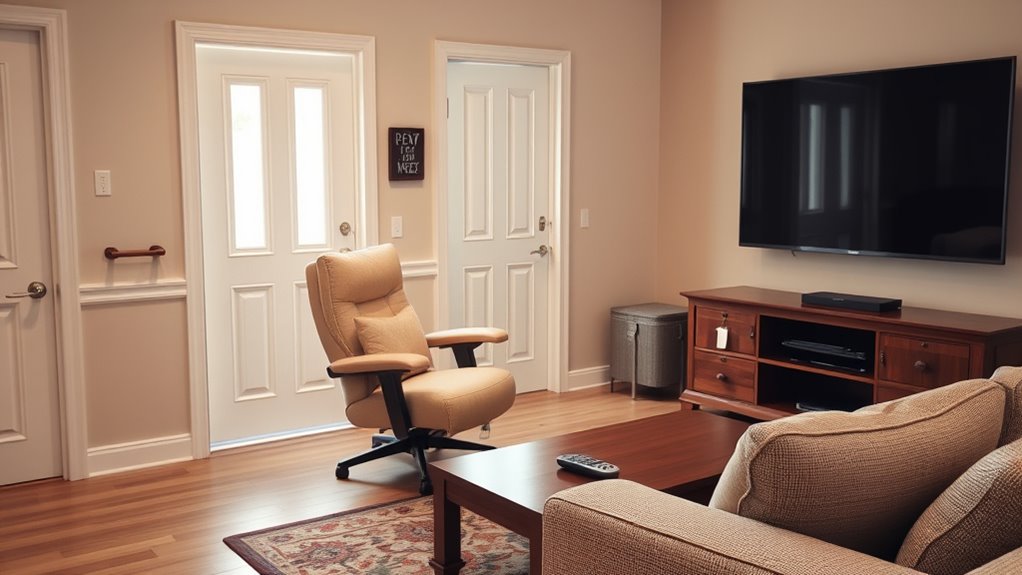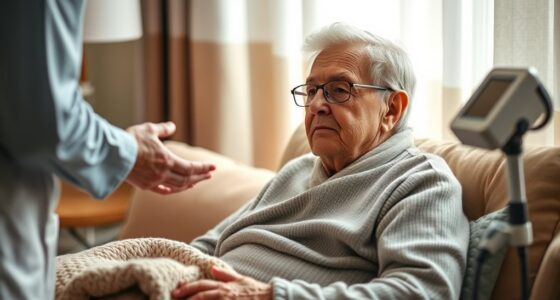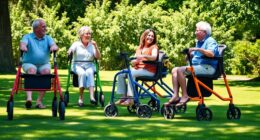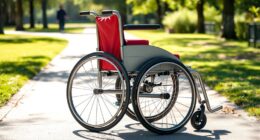To create a comfortable home for someone with advanced Parkinson’s, focus on installing grab bars, lever handles, and ergonomic furniture to support mobility. Use bright lighting, non-slip mats, and clear pathways to prevent falls. Organize your space to reduce clutter and make essential items easily accessible. Incorporate assistive devices and consider home technology like motion-activated lighting. With these modifications, you’ll enhance safety and comfort—more helpful tips are ahead to help you get started.
Key Takeaways
- Install grab bars and ergonomic handles to enhance stability and prevent falls during daily activities.
- Use adjustable furniture and accessible controls to accommodate mobility limitations comfortably.
- Improve lighting with bright, motion-activated lights to enhance visibility and safety throughout the home.
- Reduce clutter and organize essentials within easy reach to minimize strain and prevent accidents.
- Incorporate assistive devices and technology tailored for Parkinson’s to support independence and ease daily routines.
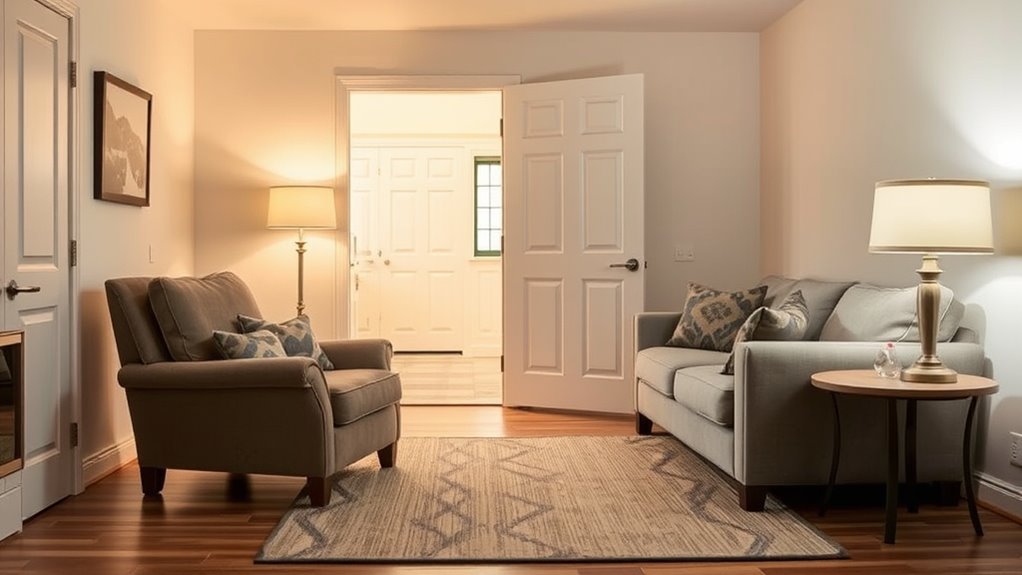
Living with Parkinson’s can make everyday tasks challenging, but simple home modifications can considerably enhance your comfort and independence. One of the most effective ways to do this is by incorporating assistive devices and ergonomic design elements into your living space. These changes are tailored to support your mobility, reduce strain, and make daily routines more manageable.
Assistive devices are essential in creating a safer environment. For example, installing grab bars in the bathroom provides stability when getting in and out of the shower or toilet. Using a walker or cane with ergonomic handles can help you maintain balance and reduce fatigue. Reaching aids or long-handled tools make it easier to grasp objects from high shelves or pick up items off the floor, minimizing the need for bending or stretching. These devices are designed to be intuitive and comfortable, helping you stay active without risking falls or injury.
Ergonomic design focuses on optimizing your home’s layout and furniture to accommodate your needs. Replacing traditional chairs with ergonomic chairs that offer proper lumbar support can alleviate back pain and improve posture. Choosing a height-adjustable bed makes getting in and out easier, especially if you experience stiffness or tremors. Lever-style door handles are easier to operate than knobs, reducing the effort required to open doors. Light switches and appliances installed at accessible heights eliminate unnecessary stretching or reaching, preventing fatigue and promoting independence.
Lighting plays a critical role in ergonomic design. Bright, well-placed lighting minimizes shadows that can cause missteps or confusion, especially in hallways and staircases. Consider installing motion-activated lights to ensure you always have sufficient illumination without fumbling for switches. Non-slip mats in the bathroom and kitchen further prevent slips and falls, creating a safer environment.
In addition, organizing your space to reduce clutter and streamline daily routines can make a significant difference. Using storage solutions that allow easy access to frequently used items reduces the need for awkward movements. Clear pathways free of obstacles help prevent trips and falls, which are particularly risky with Parkinson’s.
Furthermore, understanding the importance of assistive technology can lead to more effective support and independence in your daily life. Using devices and tools designed specifically for Parkinson’s can greatly improve your safety and ease of movement.
Together, assistive devices and ergonomic design form a holistic approach to home modification that supports your independence and safety. By making these adjustments, you can navigate your home more confidently, conserve energy, and improve your overall quality of life as you manage Parkinson’s. Remember, small changes can have a big impact, and consulting with occupational therapists or specialists can help you identify the most effective modifications tailored to your specific needs.
Frequently Asked Questions
How Can I Prevent Falls in a Modified Home?
To prevent falls in your modified home, install safety sensors that alert you to hazards and guarantee pathways are clear of clutter. Keep emergency exits easily accessible and well-lit, so you can quickly reach them if needed. Use grab bars and non-slip mats in key areas like bathrooms and hallways. Regularly check your environment for hazards, and practice safe movement to reduce the risk of falls.
What Are Cost-Effective Home Modification Options?
Think of your home as a canvas, ready for affordable solutions that won’t break the bank. DIY modifications like installing grab bars, securing rugs, and adding night lights are cost-effective ways to boost safety. You can often find inexpensive materials at hardware stores and do the work yourself, saving money. These simple, proactive changes can transform your space into a safer haven, giving you peace of mind without draining your wallet.
How Do I Choose the Right Assistive Devices?
To choose the right assistive devices, start with a safety assessment from a healthcare professional or occupational therapist. They’ll recommend assistive technology suited to your specific needs. Consider devices that improve mobility, safety, and independence, like grab bars or walking aids. Test different options if possible, and prioritize comfort and ease of use. Your healthcare team can help you select the best tools to enhance your daily living.
Are There Specific Modifications for Nighttime Comfort?
For nighttime comfort, consider adding bed rails to prevent falls and guarantee safety. Install soft, motion-activated night lights along hallways and near the bathroom to improve visibility and reduce disorientation. Keep essential items within reach, and maintain a clear, clutter-free path to the bathroom. These modifications help you feel more secure and independent at night, making it easier to navigate your home comfortably and safely.
How Can Family Members Assist With Home Adjustments?
Did you know that nearly 60% of falls in Parkinson’s patients happen at home? You can assist with home adjustments by ensuring garden safety, like removing tripping hazards, and making bathroom adaptations, such as grab bars and raised toilets. Your involvement helps create a safer environment, reducing fall risks and increasing comfort, so your loved one can enjoy independence while feeling secure in their daily routines.
Conclusion
By making these home modifications, you’re not just changing your environment—you’re creating a sanctuary where comfort and safety flourish. Think of your home as a gentle embrace, shielding you from the chaos of Parkinson’s and inviting peace. When you adapt your surroundings, you’re turning challenges into opportunities for independence. Remember, your home should be a haven where every step feels secure, and every day begins with confidence—because you deserve nothing less than comfort and care.
